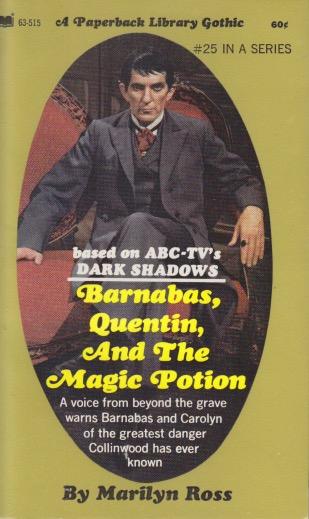
When writing fiction, I’ve never tried a series. Some, such as Harry Potter, can set a writer for life. I’ve always had the sense that the Dark Shadows novels were more potboilers. There was a built-in fan base, and somehow in the sixties and seventies we didn’t expect Rowling-level writing. It was the entire package: the Gothic, the recurring characters, the moody setting of Collinwood. And of course, Barnabas Collins. These novels may be journeyman writing, but here at number 25 in the series, Barnabas, Quentin, and the Magic Potion, there are some signs of literary improvement. They are slight, rather like the first tinging of leaves with yellow as August begins to settle in, but they are there. The series is nearing its end for me (provided I can actually find the last few books), but maybe it’s getting better.
What’s my reason for such a burst of enthusiasm? Well, in this episode we see some features of Quentin that are more in line with how I remember him. First of all, Ross tries some misdirection. Quentin is presented as a master of disguise in the series and here there’s some clever hinting that, if you’re trying to think it through, leads you to mis-guess early on. Not only that, but there’s a more positive view of Quentin here. He’s not the evil satanist that he is earlier in the series. Perhaps Ross had figured out by now that if people liked the idea of a Barnabas who is a conflicted victim, the same might apply to Quentin. He’s not evil, but when you’re a werewolf, well, what can you do?
The “magic potion” is just as contrived and sketchy as most of the plot devices in this series—Harry Potter this is not. It’s just a get rich quick scheme for a reprehensible old man and serves to move the plot along without really adding anything to it. Carolyn here discovers that Barnabas is a vampire and, it seems to me, some of the plot devices for the Tim Burton movie might’ve been picked up from this particular novelization. Although still not belle lettres by any stretch, the story here seems to have made some progress over the previous 24. As a child, of course, I didn’t read these in order. I relied on what I found at the bin in Goodwill, when I could find them. I never had the whole series. While trying at times, reading them may be a worthy exercise as an adult. Perhaps series too grow up.
